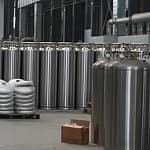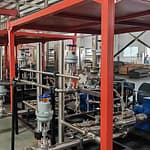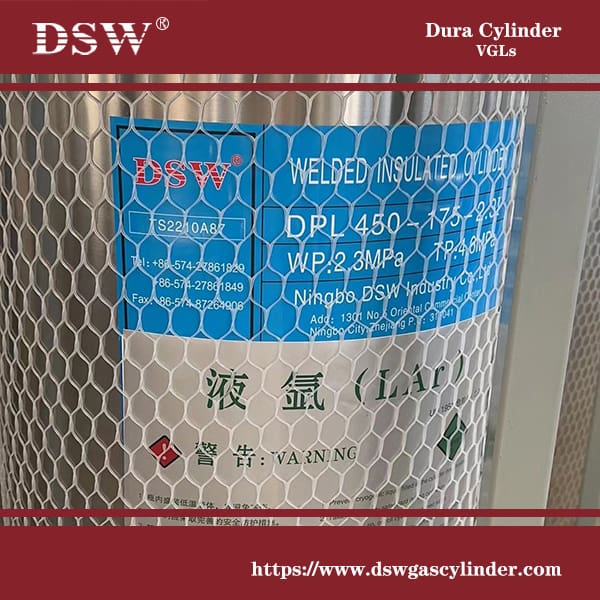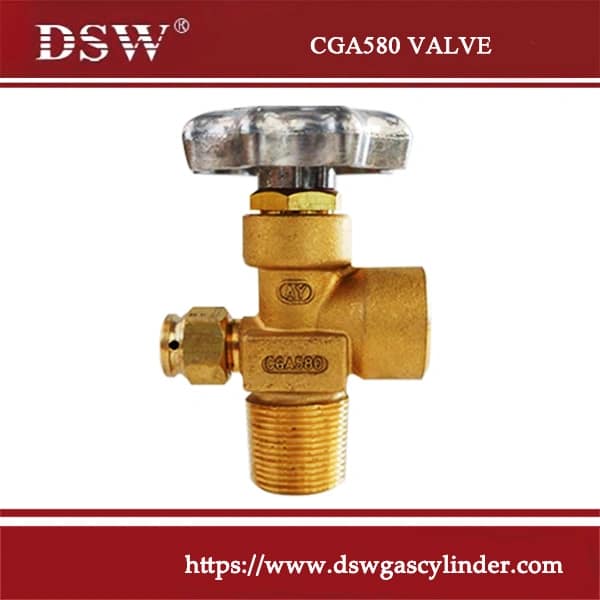Currently, industrial gases most widely employed belong to bottled gas cylinders, and their use includes volumetric quantities and more complex species.
Generalized steel gas cylinders should include various pressures, volumes, structures, and storage materials for permanent gases, liquefied gases, and disposable or reusable inflatable portable pressure vessels with different storage needs.
- From a structural classification point of view, gas cylinders can generally be divided into seamless gas cylinders and welding gas cylinders for use at room temperatures, with industrial gases most often filling these two gas cylinders. However, with ultra-low temperature sealing technology advancement, liquid oxygen, liquid hydrogen, liquid argon, liquid gas, etc., may need to be used along with cryogenic liquid gas cylinders as part of ultra-low temperature filling technology developments.
Seamless Gas Cylinders
can store oxygen, nitrogen, and argon permanent gases as well as carbon dioxide, methane, and nitrous oxide, which have higher pressure requirements at higher pressure liquefied gases like carbon dioxide. Their structure resembles the image below.

The typical structure of seamless gas cylinders
Within the world of seamless gas cylinders, their internal volumes usually range from 0.13L to 70L for most (although those regulated under Gas Cylinder Safety Supervision and seamless steel gas cylinders GB can vary between 0.4L to 80L). However, some exceedingly long gas cylinders (3.5m 7m) of 130 to 500L capacity may also be used as containers and for storage as poised containers.
China manufactures seamless gas cylinders with less convex bottom (except when used for particular gas cylinder respirator use) and nearly all of the excellent stability associated with concave bottom gas cylinders.
2. Welding Gas Cylinders
Ammonia, chlorine, freon, liquefied petroleum gas, and other low-pressure liquefied gases used in welding gas cylinders have different shapes from seamless gas cylinders used for other uses, with often short rough shapes as its representation structure:
A typical structure of welding gas cylinders
(1)One deep red type gas cylinder (two gas cylinders combined).
Only a ring weld on a bottle represents a LPG gas cylinder; foreign 40-liter acetylene gas cylinders also utilize this structure.
First, assemble a deep-drawing steelhead to insert the bottle into its cup with a two-piece head assembly featuring a weldable ring into the body portion for welding purposes.
(2) longitudinal weld gas cylinders (3 gas cylinders assembled).
The bottle is constructed using a steel bottle with rolled steel material and then welded longitudinal seams; assembly occurs after letters 1 and 2, the crowd begins, down accumulation occurs then the fuse phase is reached as seen with LPG gas cylinders or liquid chlorine ammonia and acetylene cylinders.
(3) These gas cylinders include ignition gas cylinders, refreshing drinks with shells, and small carbon dioxide gas cylinders.
2. By Material Classification
Gas cylinder materials typically comprise steel or seamless aluminum alloy gas cylinders. However, manufacturing and sales activities to fulfill specific purposes have begun on a full scale.
1. Steel gas cylinders from GB5099-85 meet all relevant specifications that ensure optimal performance of gas cylinders; these include carbon (C), sulfur (S), phosphorus (P), and copper (Cu). Additionally, acid-soluble aluminum content requirements have also been established to guarantee its integrity in these requirements.
(1) Steel Gas Cylinders
Gas cylinder manufacturing began domestically and internationally using carbon steel materials. Due to heavy gas cylinders, seamless versions are no longer manufactured using this material; however, foreign manufacturers continue producing 0.5L carbon dioxide gas cylinders that contain this same carbon steel composition for firefighting.
(2) Welded steel gas cylinders,
typically carbon steel seamless gas cylinders, contain about 0.5% carbon content of their billet material for good weldability with no more than 0.22% of total carbon content allowed to remain.
Two manganese steel gas cylinders will be included.
Domestic seamless gas cylinders now use fierce steel billets; Anshan high container plant from American Terroir Dayton (Taylor-Wharthon Cryogenics), however, was the first in China to introduce and test commission chromium-molybdenum steel gas cylinder quenching production line and testing commissioning under production technology appraisal in 1991 production technology appraisal. According to GB 5099-85, regulations for these two elements are limited at not more than 0.44-4.4% for carbon content, while 1.4%-1.8% for manganese content limits while advanced state regulations have seen a reduction.
(3) Cr-Mo steel gas cylinders.
At present, seamless gas cylinders are widely used overseas, with over 85% using chrome-molybdenum steel manufacture as their material of choice. Carbon steel manganese gas cylinders outshone those made from chrome-molybdenum steel due to superior corrosion resistance, flexibility, toughness, and low-temperature performance. Therefore China’s “Gas Cylinder Safety Supervision” provisions should be utilized when dealing with cold areas such as gas cylinders.
Four stainless steel gas cylinders will be provided.
Foreign matter seamless gas cylinders (or welding gas cylinders), manufactured of stainless steel for particular purposes, typically contain eight percent nickel (Ni) and 18 percent chromium (Cr) content; commonly, Ni-Cr-Mo-V steel is also utilized to make our seamless stainless steel gas cylinders available to use with purity gases and corrosive gases; their low-temperature impact properties make stainless steel perfect for cryogenic liquid gas applications as its common temperature impact properties provide superior impact protection; our seamless stainless steel gas cylinders have yet to be included as standard products within our traditional manufacturing.
2. Aluminum gas cylinders
On June 1, 1990, the “seamless aluminum gas cylinders” standard, GB11640-89, came into effect.

This gas cylinder offers outstanding low-temperature impact resistance, lightweight bottles (compared to carbon steel or manganese steel gas cylinders of lightweight), corrosion resistance, sound insulation properties, and sound transmission reduction.
3. Composite gas cylinders
Composite gas cylinders (or “composite” for short) are bottled gas cylinders of multiple materials. A typical example is FRP gas cylinders; they use metal for their inner vessel (also called bottle bile). They then wrap the outer cylinder with high-strength fibers for reinforcement purposes before curing to form more robust composite gas cylinders.
4. Other materials gas cylinders
Nickel (Ni), copper (Cu), and other materials manufactured into foreign gas cylinders do not fit our manufacturing process well.
3. Gas Filling Medium Classification
Based on its state, gas can be divided into permanent, liquid, and dissolution cylinders when filling is completed.
1. Permanent gas cylinders
Hydrogen and oxygen at room temperature can also be stored as compressed gases in compressed gas cylinders for transporting purposes.
2. Liquefied gas cylinders
Compressed and liquefied gases such as chlorine and LPG gas cylinders must remain under normal temperature conditions to remain safe.
3. Acetylene gas cylinders
This method involves dissolving acetylene into acetone and then filling gas cylinders with it; any dissolved gases produced are then stored with the filler; in some countries (such as Japan), no regulations restrict this dissolution, but instead as compressed oxygen gas or liquefied acetylene gas is available; thus two categories exist for gas cylinders: compressed and noncompressed ones.
1. Drawing and Ironing Gas Cylinders.
This method, known internationally as Earhart Act (E-type), involves punching and pulling gas cylinders made of stretch and heal. Bottom punch stretching drawing into the legal system or H-type gas cylinders (primarily female) are the primary types of seamless gas cylinders used.
2. Pipe-shut gas cylinders
This method, known as Mannesmann (M-type), refers to processing seamless steel pipe. This process for seamless gas cylinders involves making most of them convex to solve the stability issues of standing gas cylinders and then placing them on bases for loading purposes. Many gas cylinders manufactured overseas (and over half their efficiency), such as those found at gas cylinder suppliers in foreign countries, are manufactured as convex-to-concave bottom-Zaiding models resulting in their appearance and formal resolution on imperfect surfaces.
3. Stamping Stretch Gas Cylinders
This method, commonly called Ancient Carbene (C-type), involves deep drawing steel cups before closing their open ends to complete processing. Material utilization is low, while process complexity makes this difficult and inflexible for wide-scale use; American PST Company (pressed Steel Tank Co. INC) utilizes this process when handling larger gas cylinders 71.36L or above.
These three processes serve as the manufacturing method of seamless gas cylinders.
4. Welding gas cylinders
Pat is not covering this subject within her structure classification; therefore, it will not be included here.
5. Wire gas cylinders in place
Reinforcing layers are employed on gas cylinder barrels as an additional layer to increase strength, with one or more high-strength steel wires externally wrapped as reinforcement to bolster their power and reinforce composite materials.
5. Gas cylinders can be divided into six categories: nominal working pressure or hydrostatic test pressure classification.
1. Gas Cylinders with High-Pressure Filling Capabilities
Nominal Working Pressure of High-Pressure Cylinders for 8-30Mpa Hydrostatic Testing Pressure.
2. Low-pressure gas cylinders
Nominal working pressure high-pressure cylinders for 8-30MPa hydrostatic pressure testing; hydrostatic testing pressure range 1245MPa.
6. From the classification system: 1 General gas cylinders
This category means there are no specific requirements for gas cylinders.
2. Special Gas Cylinders
Specialty gas cylinders can be found across industries like electronics, aerospace, medical, security, and rescue services, with specific needs for structure, materials, or performance requirements for these unique gas cylinders.
7. By Shape Classification. 1 Bottle-shaped Bottle; 7 Concave Bottom Gas Cylinders
Two convex bottom gas cylinders;
(3) End of the gas cylinder with convex base;
4. H-shaped bottom gas cylinders;
Bucket gas cylinders are chlorine or ammonia-filled barrel gas cylinders and should only be used with approved equipment.
3. Cylinders with spherical gas storage capabilities.
4. Gourd-shaped bottle.
















No comment